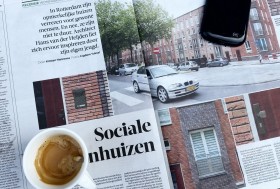25 June 2015 – In the newspaper De Volkskrant of today Kirsten Hannema gives four stars to the ‘social mansions’ at Oranjeboomstraat. She wrote a double article on the first realised project of my new studio in Amsterdam and on the state of affairs of the Dutch social housing sector.
At our visit to the dwellings at Oranjeboomstraat I had told her about my youth in Prinsenhof in the outskirts of The Hague. ‘His point of departure is [and will remain] the housing estate where he used to live as a boy, in Leidschendam. The memories of the unconsoling entrance lobby with a ceiling full of heating pipes from which decaying insulating material kept falling off. That could be better, he decided. That became his mission as architect. Mission accomplished – one cannot conclude any different when looking at the classy entrance doors in Rotterdam.’
Kirsten Hannema is more worried about the situation in which the social housing sector has found itself back after all political interventions and scandals. She concludes her article by returning to the urban qualities of the Oranjeboomstraat project. ‘The significance of this project reaches further than the question what type of housing we bestow on people with a low income. It forces us also to think about the collective value of social housing. The tendency with housing trusts is, from a viewpoint of cost effectiveness, to collaborate more with the building industry which has construction systems readily available, sometimes even supplied with explicit stylistic features. They are sound dwellings, that’s not the issue at all. They just don’t have anything to do with the place where they are erected. Here the opposite is true. The architecture is at its strongest while walking through Oranjeboomstraat. Then one experiences the rhythm and the relief of the facades, the false perspective of the zigzagging roofline and subtle junctions next to the exisiting buildings. An then one realises that these 42 houses are much more than the indispensable living space they provide for the many large families in South Rotterdam, namely: a piece of city.’
